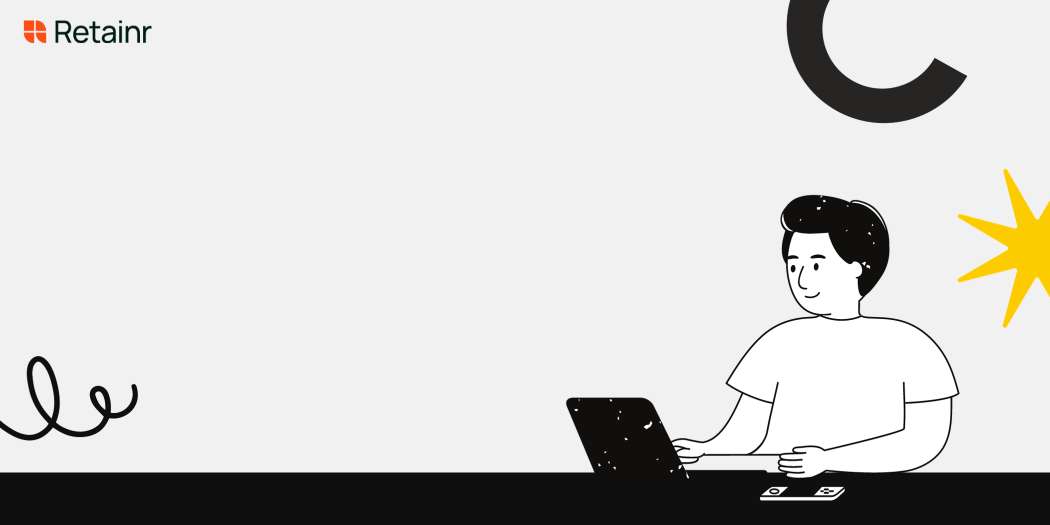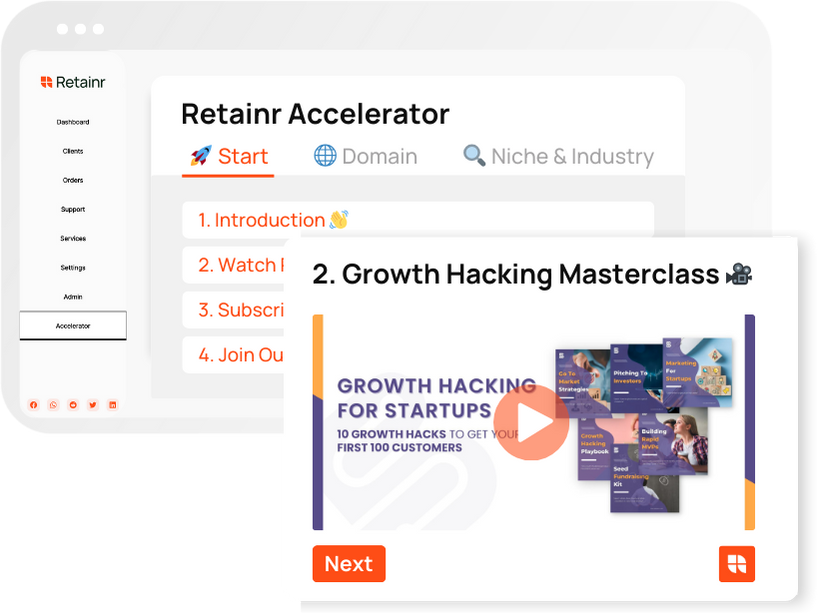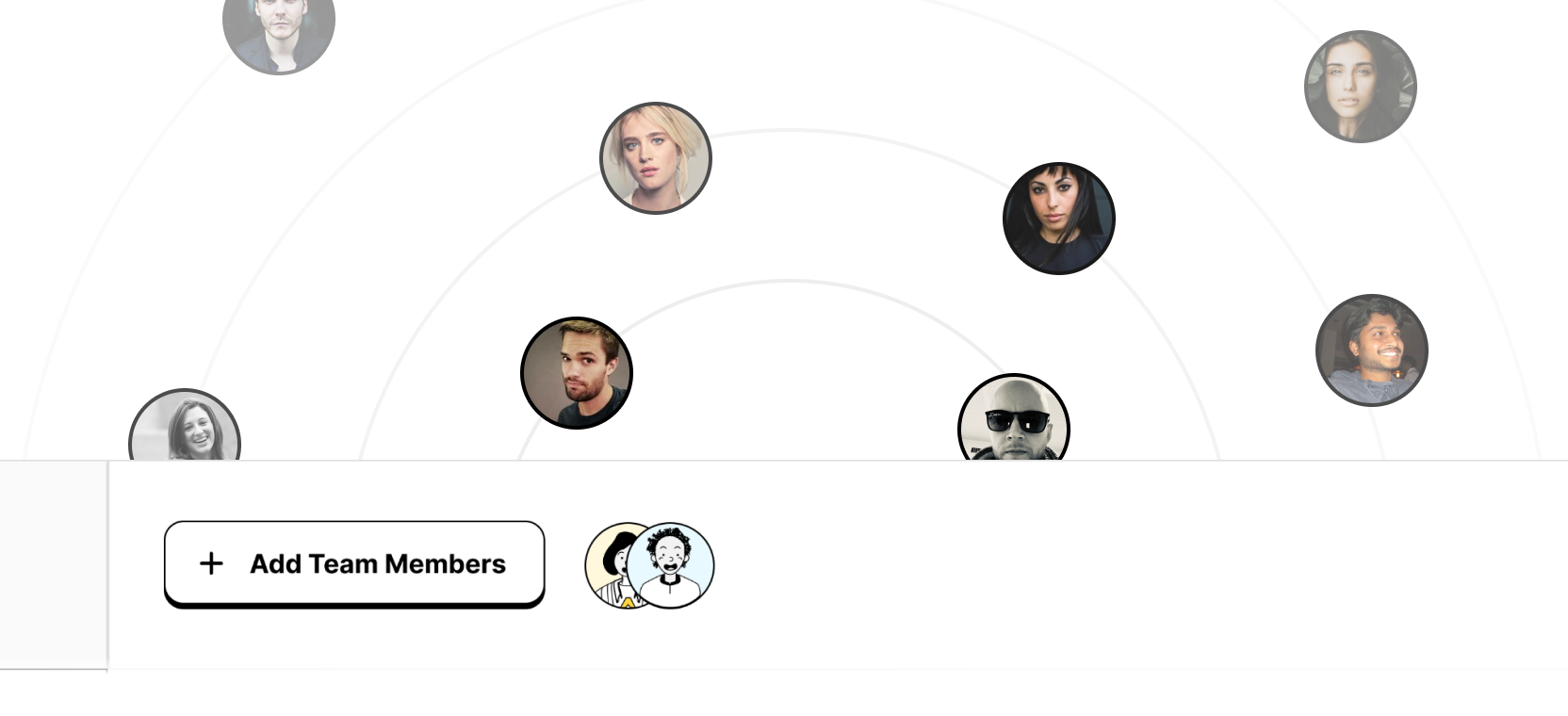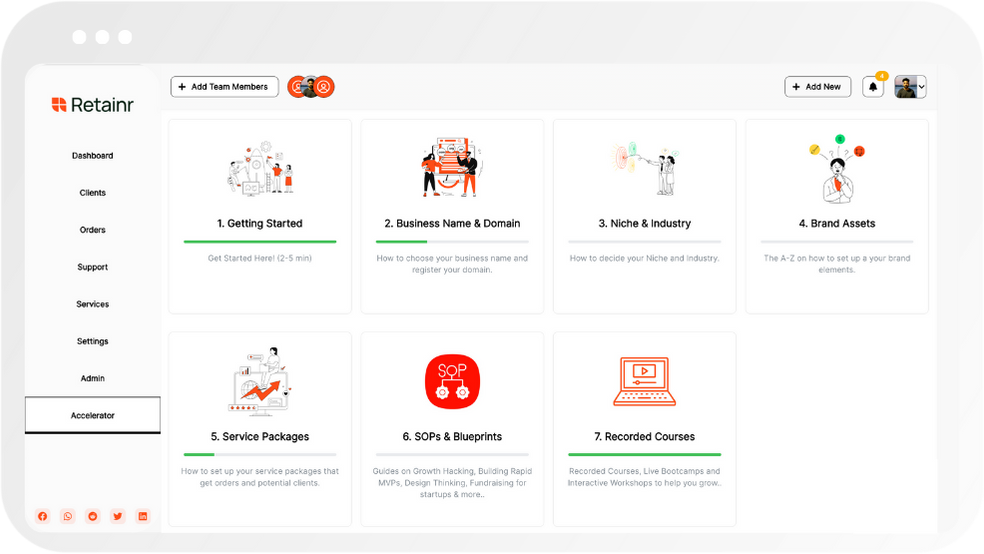
15 Task Tracking Techniques to Streamline Your Workflow
Build with Retainr
Sell your products and services, manage clients, orders, payments, automate your client onboarding and management with your own branded web application.
Get Started1. What are the top 15 task tracking techniques to streamline a workflow?
Top 15 task tracking techniques
Improving your efficiency is all about implementing a reliable tracking system that makes it easier to manage your tasks. Here are the top 15 task tracking techniques to streamline your workflow:
- Using project management software: Tools like Asana or Trello can help keep all your tasks in one place and track their progress.
- Time tracking: Using apps to record the time spent on each task to identify areas that need improvement.
- Establishing priority list: Listing tasks in order of importance for better focus and productivity.
- Kanban Boards: Visualizing workflow using cards and columns to track the progress of tasks.
- Setting SMART goals: Specific, Measurable, Achievable, Relevant, Time-bound goals to have a clear vision of what needs to be done.
- Checklists: Simple, practical, and effective for keeping track of completed tasks.
- Batching tasks: Grouping similar tasks together to avoid the cost of task switching.
- Agile and Scrum methodologies: Adapting these methodologies can improve efficiency in project management.
- Automating repetitive tasks: Using automation tools to take over monotonous tasks and save time.
- Using a workspace tool: Using platforms like Slack or Google Workspace for communication and scheduling.
- Gantt Charts: Visual timeline that shows task dependencies, durations, and current task progress.
- Inventory management: Storage and organization of tasks or information for easy access and retrieval.
- Critical Path Method: An algorithm for scheduling tasks in a project.
- Using a digital calendar: Scheduling and coordinating tasks and meetings in one place.
- Task delegation: Assigning tasks to team members to ensure effective distribution of work.
Impact of These Techniques
These techniques will have different impacts depending on your needs and how you apply them into your workflow. At the end of the day, the objective is to reduce inefficiencies, boost productivity, and deliver high-quality work on-time. Use this table as a guide for which technique might suit your needs:
| Technique | Suitable for |
|---|---|
| Using project management software | Teams handling multiple projects |
| Time tracking | Freelancers and hourly workers |
2. How can task tracking techniques improve efficiency in the workplace?
Benefits of Task Tracking Techniques for Efficiency
Task tracking techniques play an essential role in improving efficiency in the workplace. Firstly, they help in maintaining focus on the task at hand, by providing a visible framework for what needs to be done. This encourages employees to be diligent about their work and ensures that time isn't wasted on unimportant tasks. Secondly, these techniques allow for a better distribution of tasks among team members. By keeping track of who is doing what, managers can ensure that workloads are evenly distributed and that no one is overloaded.
Top Five Task Tracking Techniques for Efficiency
- Prioritization: Ranking tasks based on their urgency and importance.
- Time blocking: Dedicating specific time slots for different tasks in the day.
- Batching: Grouping similar tasks together to be done in one sitting.
- Delegation: Assigning tasks to appropriate team members.
- Use of project management tools: Utilizing digital tools that facilitate task tracking and workflow management.
Table Representation of Task Tracking Techniques
| Technique | How it improves efficiency |
|---|---|
| Prioritization | Helps in focusing on high-value tasks first and avoids wasting time on less important tasks. |
| Time blocking | Prevents multitasking and ensures dedicated focus on each task at hand. |
| Batching | Reduces context switching and allows for more efficient work on similar tasks. |
| Delegation | Negates employee overwork by assigning tasks based on individuals’ expertise and capacity. |
| Use of project management tools | Provides real-time track of tasks as well as visual representation of the workflow for better management. |
3. Can the implementation of task tracking techniques reduce work-related stress?
Benefits of Implementing Task Tracking Techniques
Implementing task tracking techniques can significantly reduce work-related stress. One of the major causes of such stress is the feeling of being overwhelmed with too many tasks, not knowing where to start or what prioritizes to set. Task tracking techniques provide a concrete and visual way to manage these tasks, contributing to stress reduction in several ways:
- Creates organization: When everything is laid out in a systematic manner, it's easier to see what needs to be done and when.
- Enhances efficiency: With these techniques, you can easily identify tasks that are taking longer than necessary, quickly take corrective measures and thereby reduce associated stress.
- Better delegation: Task tracking techniques often make it easier to see who is doing what and can help redistribute tasks more evenly to prevent burnout.
Impact of Task Tracking on Work-Related Stress
The table below further illustrates how task tracking techniques can decrease several stress-related factors that are present in a typical work environment.
| Stress-related factors | How task tracking helps |
|---|---|
| Overload | Task tracking allows for prioritization, making it clear what needs your attention first and thus reduces the sense of overload. |
| Unclear job expectations | With task tracking, duties and responsibilities are clearly outlined, thereby eliminating any confusion over job expectations. |
| Time pressure | Task tracking can provide an accurate estimate of time needed for each task, reducing time pressure by ensuring tasks are completed in a timely manner. |
Choosing the Right Task Tracking Technique
Choosing the right task tracking technique is crucial. Involve your team in the decision-making process for better acceptance and efficiency. While there are many techniques, some of the most effective ones for reducing work-related stress are:
- Kanban Technique: Visually displays tasks at all stages of the process, making it easy to view progress and manage workloads.
- GTD (Getting Things Done) Technique: A time management method ensuring that tasks are captured, clarified, organized, reflected upon and engaged with effectively.
- Scrum Method: This agile framework encourages collaboration, flexibility, and quicker problem-solving.
4. How does prioritizing tasks aid in workflow streamlining?
Prioritization as a Task Tracking Technique
Prioritizing tasks is a powerful technique that aids tremendously in streamlining workflow. It ensures that you focus on completing tasks that hold high importance and great urgency first. Consequently, saving you from the time-consuming activity of figuring out what to do next during the workflow. Prioritizing can be especially useful during a hectic day when you are burdened with multiple tasks all seeming equally important.
The Benefits of Task Prioritization
- Increased productivity: By putting priorities in place, you eliminate the time spent deciding what task to tackle next, which in turn increases productivity levels.
- Improved time management: It often helps in estimating and allocating the right amount of time for each task. You can assure that no single task overshadows or interferes with the others.
- Reduced stress: Knowing what needs to be done first and having a clear plan of action can greatly reduce stress and anxiety related to workloads.
- Enhanced quality of work: Prioritizing tasks ensures that you are not rushing through important tasks which can help in improving the overall quality of your work.
Table of Prioritization Techniques
| Technique | Description |
| Eisenhower matrix | It divides tasks into four categories based on urgency and importance. |
| ABC Method | Tasks are divided into three categories: A (highest priority), B (medium priority), C (lowest priority). |
| Time-based Method | Tasks are prioritized based on the time required for completion. |
| Value-based Method | Tasks are prioritized based on the estimated value they add to the project or business. |
5. Are there specific software or tools that can help in task tracking across different industries?
Task Tracking Software Across Different Industries
Yes, there are various task tracking software tools that can assist in simplifying workflow across multiple industries. These tools can be tailored to fit the specific needs of various sectors including technology, education, healthcare, manufacturing, retail, and more. Notable task tracking tools include:
- Asana: A comprehensive project management tool ideal for tracking daily tasks, team collaboration, and setting priorities.
- Trello: A flexible, visual tool for organizing, assigning, and tracking tasks using boards and cards.
- Monday.com: Serves organizations with time tracking, workflow automation, and project planning.
- Wrike: A versatile tool that supports multi-department task management in larger organizations.
- Slack: Best for communication-centric task management and instant messaging in organizations.
Software Features and Industries They Serve
The table below shows the software mentioned above with their unique features and the industries they best serve:
| Software | Features | Best Use Case |
|---|---|---|
| Asana | Team collaboration, Task tracking, Setting priorities | Technology, Education |
| Trello | Organizing and assigning tasks, kanban boards | Marketing, Software Development |
| Monday.com | Time tracking, Workflow Automation, Project Planning | Real Estate, Human Resource |
| Wrike | Multi-department Task Management | Manufacturing, Retail |
| Slack | Communication-centric Task Management, Instant Messaging | Start-ups, Media Industry |
Conclusion
Overall, it is clear how task tracking tools can aid various industries. By understanding unique industry needs and choosing the right software to meet those demands, businesses can streamline workflows, increase productivity, and enhance communication.
6. How can I adapt these task tracking techniques to remote work environments?
Adapting Task Tracking Techniques for Remote Work
The shift to remote work has made it more pertinent to correctly track tasks and monitor productivity. Task tracking techniques that work well in physical offices can be tweaked to fit the remote work environments. Here are some techniques:
- Use digital tools: With remote work, task tracking also needs to move online. Products like Asana, Trello, and Jira offer solutions catering specifically to remote task management. They allow you to detail tasks, set deadlines, and monitor progress.
- Use video conferencing: Regular check-ins using video conferencing tools help keep everyone updated about evolving tasks and priorities. These are also great venues for task clarifications and group problem-solving.
- Implement time tracking: Using time tracking software can help managers to ensure that time is being used efficiently and tasks are being handled promptly.
Comparing Task Tracking Techniques
To show you the effectiveness of these adaptation methods, let's compare the different task tracking techniques and their aptness to remote work environments.
| Technique | Applicability to Remote Work |
|---|---|
| Using Digital Tools | Very High |
| Regular Check-ins | High |
| Time Tracking | Medium |
Maximizing Efficiency
The final step to effectively adapt these task tracking techniques to your remote work environment involves continuous assessment and adjustment. Always seek feedback from your team about the tracking system in place. You can make use of Google Forms or a quick video call to get feedback and inputs for improvements. Never be hesitant to experiment and explore different methods that could tailor-fit your remote team's requisites.
7. What is the role of delegation and clear communication in task tracking for streamlined workflows?
Role of Delegation in Task Tracking for Streamlined Workflows
Delegation plays a pivotal role in task tracking and resulting in streamlined workflows. It facilitates the efficient utilization of resources, promotes responsibility, and enhances productivity within the team. Key benefits of task delegation are:
- Increases Productiveness: By assigning each task to an individual or team whose skills are best suited to the task at hand, the overall productivity of the team and the project's timeline improve.
- Reduces Workload: Delegation aids in balancing the workload among team members. This reduces the risk of burnout and maintains a high level of motivation within the team.
- Facilitates Multi-tasking: Delegated tasks can be executed in parallel, thereby facilitating multitasking, improving time-efficiency and speeding up project completion.
Role of Clear Communication in Task Tracking for Streamlined Workflows
Clear communication is vital in task tracking to ensure all stakeholders are on the same page. It increases transparency, mitigates potential misunderstandings, and promotes mutual understanding. Here's how clear communication aids task tracking:
- Enhances Clarity and Direction: Clear communication provides everyone with a precise understanding of the task requirements, deadlines, and expected outcomes. This eliminates confusion and ensures everyone is working towards the same goal.
- Promotes Accountability: When tasks, roles, and responsibilities are communicated clearly, there is a higher level of individual accountability. This leads to better task ownership and responsibility among team members.
- Reduces Errors: Clear communication minimizes misinterpretations and assumptions, reducing errors and rework. Therefore, increasing efficiency and productivity.
Combining Delegation and Clear Communication in Task Tracking
| Delegation | Clear Communication | |
|---|---|---|
| Task Allocation | Assigning the appropriate person or team best suited to a specific task | Providing all relevant details, guidelines, and deadlines related to the task |
| Progress Tracking | Ensuring that the delegated task is being executed efficiently | Keeping all stakeholders informed about the progress and any potential issues |
| Problem Resolution | Facilitating adjustments, re-assignment or provision of additional resources if needed | Communicating any issues in the task execution and collaborating on finding solutions |
These two integral components, when used effectively in task tracking, can streamline workflows, increase team productivity, and enhance overall project management success.
8. Could you provide examples of successful companies that have benefited from these task tracking techniques?
Examples of Successful Companies Benefiting from Task Tracking Techniques
Several leading corporations have leveraged task tracking techniques to augment their workflow and magnify productivity. Companies such as Google, Amazon, and Facebook exemplify the effective implementation of these strategies, realizing substantial gains in efficiency, task prioritization, and project execution.
- Google: Renowned for its innovative work culture, Google uses internal task management tools that resemble bug tracking systems. Google's system enables them to assign, monitor, and prioritize tasks effectively. Their approach emphasizes individual autonomy balanced with team collaboration, contributing to its outstanding market performance.
- Amazon: The ecommerce giant Amazon utilizes task tracking rigorously in its workflow management. Order tracking, stock management, and communication are all handled centrally, minimising discrepancies and ensuring seamless operations. Amazon also employs task tracking in its project development, enhancing project outcomes by efficient task assignment and time management.
- Facebook: As a global social media leader, Facebook relies on task tracking systems to handle the vast ocean of data and user-generated content. Their task tracking methods have played a significant role in enhancing their moderation efforts, content scheduling, and development projects while preserving their high standards of user experience.
| Company | Benefits |
|---|---|
| Improved task assignment, monitoring, and prioritization leading to enhanced productivity. | |
| Amazon | Streamlined operations in order tracking, stock management, and communication. Enhanced project outcomes through efficient task management. |
| Effective management of vast data and content, improved moderation efforts, superior content scheduling, and successful development projects. |
9. How can these task tracking techniques support multitasking or handling complex tasks?
Effectiveness of Task Tracking Techniques in Multitasking
Task tracking techniques can significantly support multitasking and efficiently managing complex tasks. For instance, time-blocking, a popular technique, encourages segregating the day into blocks of dedicated time for each task. This method ensures focus on one task at a time, thereby minimizing distractions. Prioritization of tasks based on urgency and importance, often labeled as the Eisenhower box, aids in the simultaneous completion of multiple tasks without feeling overwhelmed.
- Time Blocking: Allocate specific times during the day for each task.
- Eisenhower Box: Prioritize tasks based on their urgency and importance.
Assisting Complex Tasks with Task Tracking Techniques
When it comes to complex tasks, task decomposition and the use of project management tools are two effective techniques. Task decomposition involves breaking down a complex task into smaller, more manageable tasks. This makes the daunting task less overwhelming and helps keep track of each component with ease. Project management tools, on the other hand, allow visualization of the project's progression, making it easier to synchronize multiple elements of a complex task.
- Task Decomposition: Break down complex tasks into smaller, manageable tasks.
- Project Management Tools: Visualize the project's progression to easily synchronize multiple elements of a task.
Tabulated Comparison of Tracking Techniques
Below is a comparison of the four predominant task tracking techniques useful for multitasking and handling complex tasks:
| Technique | Multitasking Support | Complex Task Handling |
|---|---|---|
| Time Blocking | Enables focusing on one task at a time | Not ideal for complex tasks |
| Eisenhower Box | Fosters simultaneous completion of multiple tasks | Doesn't directly assist in complex tasks |
| Task Decomposition | Not particularly designed for multitasking | Great for breaking down and managing complex tasks |
| Project Management Tools | Helps juggling multiple tasks efficiently | Excellent for visualization of complex tasks |
10. How often should progress or results be evaluated when using task tracking techniques?
Frequency of Evaluating Progress or Results
The frequency of evaluating progress or results when using task tracking techniques may vary depending on the nature of the project, the set goals, and the complexity of the tasks at hand. Regardless, there are three common intervals that project managers typically utilize: daily, weekly, and monthly evaluations.
- Daily: Checking daily progress is beneficial for tasks that are critical or time-sensitive. This could be an end-of-day review of what has been accomplished or tracking progress using a digital task management system in real-time.
- Weekly: For longer, more complex tasks, a weekly review may be more appropriate. This provides a broader picture of progress and allows for adjustments to be made before too much time has passed.
- Monthly: Monthly evaluations offer an opportunity to reflect on larger goals and assess overall project performance. This involves analyzing trends, identifying potential bottlenecks and evaluating whether the project is on track to meet its objectives.
Adapting Evaluation Frequency
While these intervals are commonly used, it's important to adapt the frequency of evaluations to the unique needs of each project. In some cases, more frequent evaluations might be necessary, while in others, evaluating progress too often can be counterproductive. Here are some factors to consider:
| Factor | High Frequency | Low Frequency |
|---|---|---|
| Task urgency | Highly urgent tasks or those with impending deadlines may require more frequent evaluation | Tasks with extended deadlines may only need occasional checks |
| Task complexity | Complex tasks may necessitate regular checks to ensure correct sequence and accuracy | Simple, routine tasks may not need as frequent monitoring |
| Team size and dynamics | Large teams or teams with remote members may benefit from more frequent communication and updates | Smaller, co-located teams may find less frequent updates sufficient |
Conclusion
Improve Your Workflow with these 15 Task Tracking Techniques
To optimize task management and streamline your workflow, the incorporation of effective task tracking techniques is crucial. These techniques help in achieving the objectives, setting priorities, boosting productivity and establishing efficient work habits. Here are 15 task tracking techniques that can greatly enhance your workflow:
- Using a project management tool
- Setting deadlines
- Prioritizing tasks
- Delegating responsibilities
- Tracking progress
- Meeting strict deadlines
- Handling multiple projects
- Organizing daily tasks
- Maintaining workflows
- Collaborating with team members
- Gathering project requirements
- Aligning tasks with project goals
- Staying updated with project changes
- Managing resources efficiently
- Breaking down large tasks into manageable parts
While these techniques are proven to enhance workflow, they require a tool efficient enough to handle these functions. That is where Retainr.io comes in; a whitelabel software that is designed to Sell, Manage Clients, Orders & Payments with your Own Branded App. With Retainr.io, managing your tasks becomes easier, smoother, and way more streamlined. Try it today and experience a significant improvement in your workflow management.
Discover Better Workflow Management with Retainr.io
Retainr.io is not just another task management tool. It's an all-in-one solution that allows you to manage clients, orders, and payments in one place, with your own branded app. It's designed with efficiency and productivity in mind, helping you and your team stay on top of your work, manage commitments, and deliver on time, every time.
Whether you're a freelancer handling multiple clients, a start-up trying to keep things under control, or a large corporation in need of organizing tasks effectively, Retainr.io has you covered. It puts you in control and makes task tracking simple, organized, and efficient.
Ready to streamline your workflow? Try Retainr.io today!
Boost Your Agency Growth
with Retainr Accelerator
Uncover secrets, strategies, and exclusive blueprints to take your agency's growth to the next level — from marketing insights to effective presentations and leveraging technology.

SOPs, Cheatsheets & Blueprints
Leverage 50+ SOPs (valued over $10K) offering practical guides, scripts, tools, hacks, templates, and cheat sheets to fast-track your startup's growth.
Connect with fellow entrepreneurs, share experiences, and get expert insights within our exclusive Facebook community.
.jpg)

Join a thriving community of growth hackers. Network, collaborate, and learn from like-minded entrepreneurs on a lifelong journey to success.

Gain expertise with recorded Courses, Live Bootcamps and interactive Workshops on topics like growth hacking, copywriting, no-code funnel building, performance marketing and more, taught by seasoned coaches & industry experts.

.jpg)

.jpeg)


